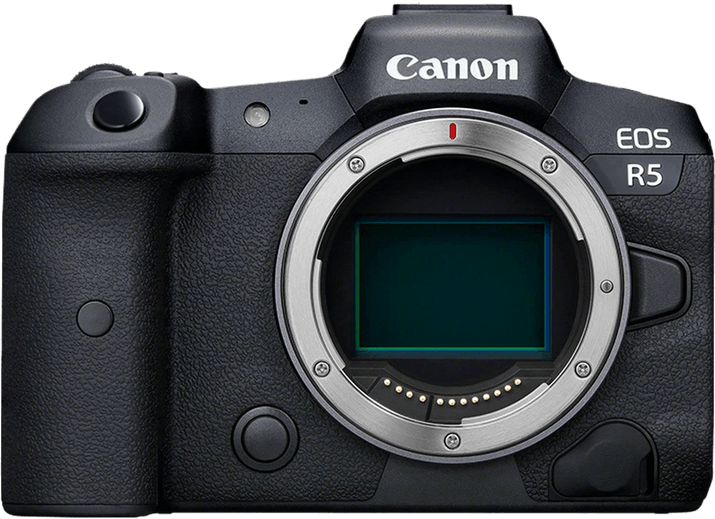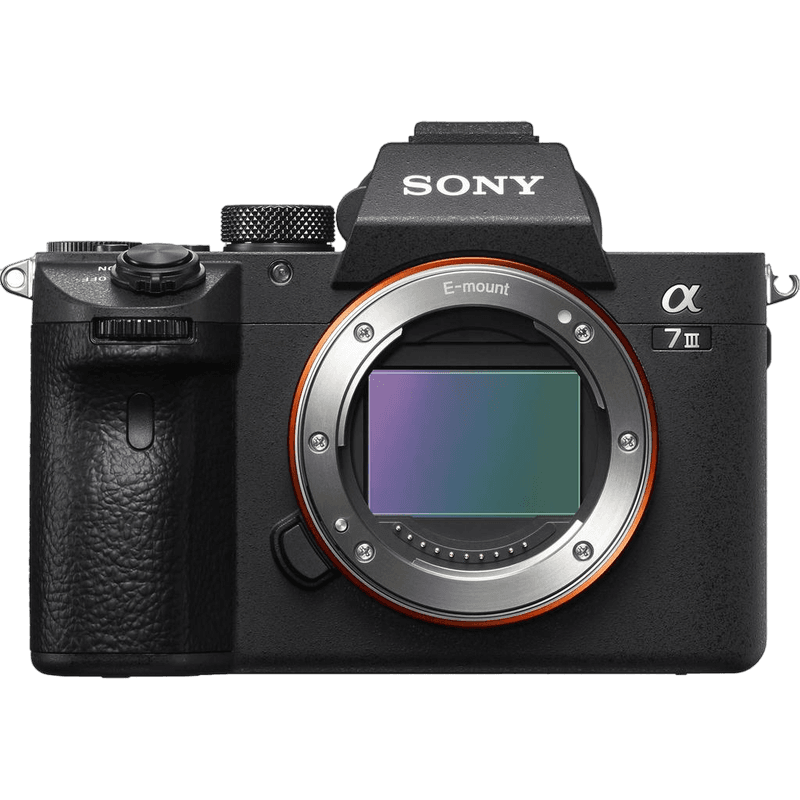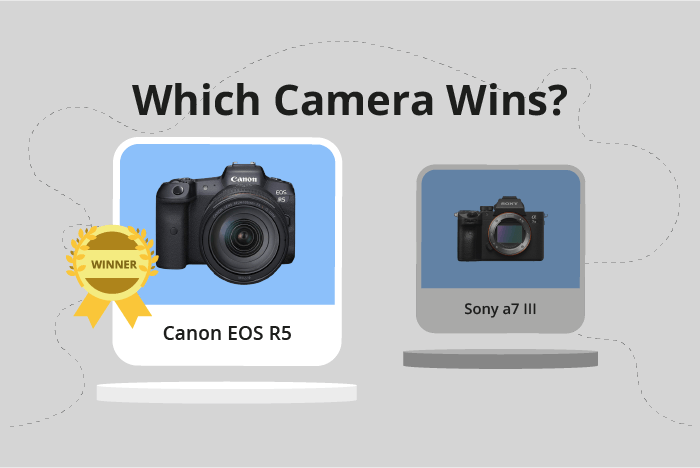Canon EOS R5 vs Sony a7 III Comparison
Canon EOS R5

Sony a7 III

The Canon EOS R5 triumphs over the Sony a7 III, scoring 86/100 compared to Sony’s 80/100. Both mirrorless cameras share similarities, such as their compact sizes and lightweight builds. The Canon EOS R5 measures 138 x 98 x 88mm and weighs 680g, while the Sony a7 III is slightly smaller and lighter at 127 x 96 x 74mm and 650g.
The Canon EOS R5 outshines the Sony a7 III with its more recent release in 2020 and advanced features, justifying its higher launch price of $4499. On the other hand, the Sony a7 III, released in 2018, offers a more budget-friendly option at $2000 without compromising too much on quality.
Considering these factors, the Canon EOS R5 is the superior choice for those seeking cutting-edge technology and top-notch performance, while the Sony a7 III remains a reliable and affordable alternative for budget-conscious photographers.
Canon EOS R5 vs Sony a7 III Overview and Optics
The Canon EOS R5 outperforms the Sony a7 III in optics with a score of 88/100 compared to Sony’s 81/100. Both cameras share some common specifications, such as having a CMOS sensor, a full-frame sensor size, and image stabilization. Additionally, both cameras use their respective proprietary lens mounts: Canon RF for the EOS R5 and Sony FE for the a7 III.
The Canon EOS R5 surpasses the Sony a7 III in several aspects. With 45 megapixels, the EOS R5 has almost twice the resolution of the a7 III, which has 24.2 megapixels. This higher resolution allows for greater detail and larger prints. The EOS R5 also boasts a shooting speed of 20 frames per second, doubling the a7 III’s 10 frames per second. This faster shooting speed is advantageous for capturing fast-moving subjects and action photography. Moreover, the EOS R5 has a superior processor, the Digic X, which contributes to faster processing and better overall performance.
Despite the lower score, the Sony a7 III still has some advantages. Its DXOMARK sensor score of 96 slightly edges out the EOS R5’s score of 95. This indicates that the a7 III’s sensor performs marginally better in terms of color depth, dynamic range, and low-light performance.
Taking these factors into account, the Canon EOS R5 is the clear winner in terms of optics, with its higher resolution, faster shooting speed, and better processor. However, the Sony a7 III remains a competitive option, especially for those prioritizing sensor performance. Ultimately, the choice between the two cameras will depend on the specific needs and preferences of the photographer.
Canon EOS R5 vs Sony a7 III Video Performance
The Canon EOS R5 outperforms the Sony a7 III in video capabilities with a significant difference in scores – the R5 scores 100/100, while the a7 III scores 56/100. Both cameras share some common video features, but the R5 excels in many aspects, making it the superior choice for video.
Both the Canon EOS R5 and Sony a7 III offer 4K video recording. However, the R5 surpasses the a7 III with its impressive 8K video resolution, allowing for much higher quality footage. The R5 also boasts a higher maximum video dimension of 8192 x 4320, compared to the a7 III’s 3840 x 2160. This difference in resolution and dimensions provides the R5 with a clear advantage in capturing detailed and sharp video content.
Another area where the Canon EOS R5 excels is its maximum video frame rate. The R5 can record up to 120fps, while the Sony a7 III is limited to 30fps. This higher frame rate allows the R5 to capture smooth slow-motion footage, providing more creative options for videographers.
The Canon EOS R5 also has a built-in time-lapse functionality, which the Sony a7 III lacks. This feature enables the R5 to create stunning time-lapse sequences without the need for additional accessories or software.
Despite its lower score, the Sony a7 III is still a capable camera for video recording, particularly for those who do not require the advanced features of the R5. However, the Canon EOS R5’s superior video capabilities make it the clear winner in this comparison. With its higher resolution, video dimensions, frame rate, and built-in time-lapse functionality, the R5 is the optimal choice for videographers seeking the best performance and quality.
Canon EOS R5 vs Sony a7 III Features and Benefits
The Canon EOS R5 outperforms the Sony a7 III with a feature score of 87 out of 100, compared to Sony’s 81. Both cameras share several specifications, including touchscreen capabilities, flip screens, and the absence of GPS. Additionally, both offer WIFI and Bluetooth connectivity.
The Canon EOS R5 surpasses the Sony a7 III in terms of screen size and resolution. The R5 has a 3.2-inch screen, while the a7 III has a 3-inch screen. Moreover, the R5’s screen resolution is significantly higher at 2,100,000 dots compared to the a7 III’s 921,600 dots. These differences contribute to the R5’s superior feature score.
On the other hand, the Sony a7 III still excels in some aspects, despite its lower feature score. The a7 III provides a reliable performance and delivers high-quality images and videos. It remains a strong contender in the market and is an excellent option for photographers who prioritize other aspects, such as price or lens availability.
In comparing the Canon EOS R5 and Sony a7 III, the R5 takes the lead with its larger screen and higher resolution. This camera is ideal for users who value a more advanced display for composing and reviewing images. The Sony a7 III, while slightly inferior in terms of features, remains a viable option for those who prefer other factors over display quality. Both cameras have their strengths and cater to different preferences, ensuring that photographers can find a suitable camera to meet their unique needs.
Canon EOS R5 vs Sony a7 III Storage and Battery
The Canon EOS R5 and Sony a7 III tie in storage and battery with a score of 68/100. Both cameras have two memory card slots and support SD/SDHC/SDXC cards. The R5 accepts CFexpress cards and UHS-II compatible cards, while the a7 III is compatible with Memory Stick Duo/Pro Duo/Pro-HG Duo cards.
The R5’s battery life is 320 shots, using an LP-E6NH battery, and has USB charging. The a7 III’s battery life is significantly longer at 750 shots, utilizing an NP-FZ100 battery, but lacks USB charging.
The R5 offers more versatile memory card options and convenient USB charging, making it ideal for users who require flexibility and on-the-go charging. The a7 III, however, provides a superior battery life, suitable for those who prioritize extended shooting sessions without the need for frequent battery changes.
Alternatives to the Canon EOS R5 and Sony a7 III
Are you still undecided about which camera is right for you? Have a look at these popular comparisons that feature the Canon EOS R5 or the Sony a7 III:

